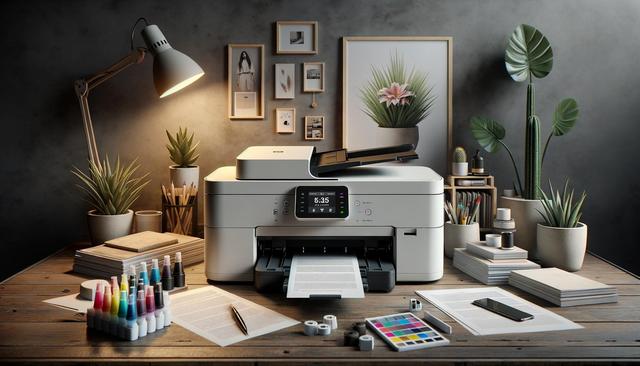
Understanding Inkjet Printers: Technology, Types, and Applications
The Basics of Inkjet Printing Technology
Inkjet printers work by spraying tiny droplets of ink directly onto paper or other substrates to create an image or text. This technology has been refined over the years, leading to more efficient and higher-resolution printing. There are two primary types of inkjet mechanisms: thermal and piezoelectric. The piezo inkjet printer uses piezoelectric crystals that flex when an electric charge is applied, forcing ink out of the nozzle. This method allows for more precise control over ink droplet size and placement, making it ideal for high-resolution printing tasks.
Another important advancement is continuous inkjet printing, where a constant stream of ink droplets is generated. These droplets are either directed onto the substrate or deflected into a recycling system. This method is commonly used in high-speed and industrial inkjet settings because of its capability to print on various surfaces at high speeds.
Types of Inkjet Printers and Their Functions
There are several types of inkjet printers, each designed for specific environments and use cases. Understanding these types can help users choose the right printer for their needs.
- Office inkjet printer: Designed for general office tasks such as printing documents, charts, and occasional graphics. These printers balance cost and performance for daily business use.
- All in one wireless inkjet printer: Combines printing, scanning, copying, and sometimes faxing functionalities in one device. The wireless feature adds convenience, especially in shared workspaces or home offices.
- Flatbed inkjet printer: Uses a flat surface for printing on rigid or thick materials. Ideal for specialty printing on items such as signs, glass, or promotional products.
- Industrial inkjet: Built for large-scale or high-speed printing in manufacturing and packaging. These printers are robust, capable of printing on a wide variety of materials including metal, plastic, and textiles.
Each of these printers serves a unique purpose and choosing the right one depends on factors like print volume, required quality, and available workspace.
Applications of Inkjet Printing Across Industries
Inkjet printing is not limited to office tasks or home photo printing. Its applications span across multiple industries, offering creative and functional solutions for various printing needs.
- Retail and Packaging: Continuous inkjet printing is widely used for printing expiration dates, barcodes, and batch numbers on packaging materials.
- Textile Industry: Advanced piezo inkjet printers are used to print intricate patterns and designs directly onto fabrics, enabling high-definition customization.
- Advertising and Signage: Flatbed inkjet printers are employed to print on surfaces like foam boards, acrylic, and metal, providing vibrant and durable signage.
- Electronics: Industrial inkjet technology is utilized to print conductive inks and patterns on circuit boards, supporting the development of flexible electronics.
These diverse applications highlight the adaptability and innovation within inkjet printing technology.
Advantages and Considerations
Inkjet printers offer several advantages that make them suitable for a broad range of users. They are generally compact, easy to use, and capable of producing high-quality images. Their ability to print in full color with smooth gradations is particularly valued in creative and design fields.
However, there are also considerations to keep in mind:
- Ink Costs: Ink cartridges can be expensive, especially for high-volume users. Some models mitigate this with refillable ink tanks.
- Print Speed: While sufficient for most tasks, standard inkjet printers may lag behind laser printers in speed, particularly in large print jobs.
- Maintenance: Inkjet nozzles can clog if not used regularly, requiring periodic cleaning to maintain print quality.
Despite these challenges, advances in continuous inkjet printing and ink delivery systems are helping to address many of these issues, improving reliability and lowering long-term costs.
Choosing the Right Inkjet Printer
When selecting an inkjet printer, it’s essential to evaluate your specific needs and match them to the features offered. For home users, an all in one wireless inkjet printer offers flexibility and ease of use. Offices that handle a mix of text and graphics printing may benefit from a reliable office inkjet printer with moderate speed and output quality.
For industrial settings, continuous inkjet and industrial inkjet printers provide the durability, speed, and material compatibility needed for demanding applications. Similarly, creative professionals may find the flatbed inkjet printer to be a practical choice for producing high-quality prints on diverse surfaces.
Key factors to consider include:
- Print resolution and color accuracy
- Ink system and refilling options
- Connectivity features like wireless or mobile printing
- Supported media types and sizes
- Maintenance and support availability
Taking the time to assess these aspects ensures that the chosen printer aligns with long-term printing goals and budget.
Conclusion: Finding the Right Fit for Your Printing Needs
Inkjet printers have come a long way from their early beginnings, now offering a range of solutions tailored to individual, business, and industrial needs. Whether you’re looking for a versatile all in one wireless inkjet printer for your home office or a heavy-duty industrial inkjet system for high-volume production, understanding the different types and technologies involved is key. With careful consideration, users can select a model that delivers consistent quality, efficiency, and value for their specific applications.

